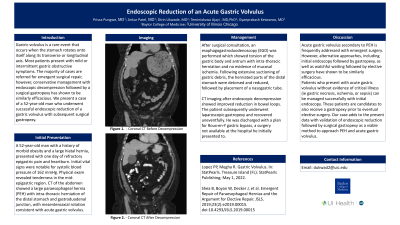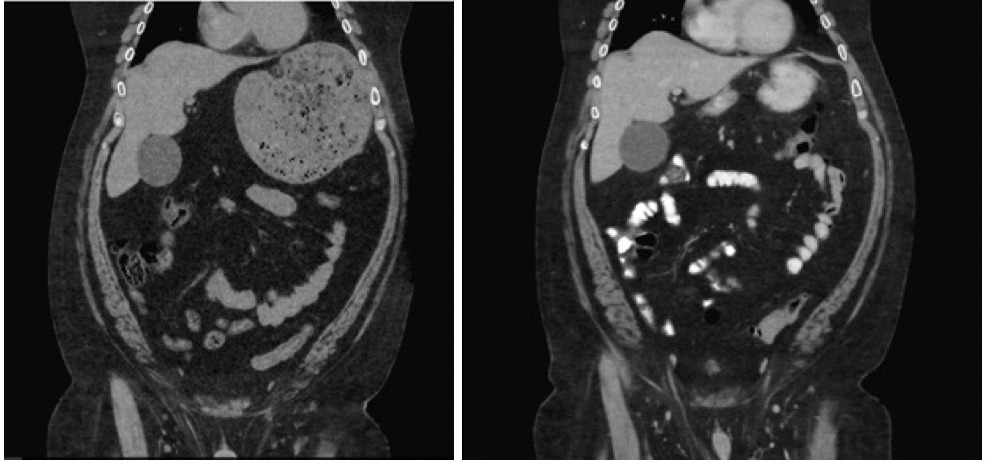Sunday Poster Session
Category: Stomach
P1414 - Endoscopic Reduction of an Acute Gastric Volvulus
Sunday, October 22, 2023
3:30 PM - 7:00 PM PT
Location: Exhibit Hall

Has Audio

Dirin Ukwade, MD
University of Illinois Chicago
Chicago, IL
Presenting Author(s)
Dirin Ukwade, MD1, Prisca Pungwe, MD2, Ankur Patel, MD2, Teminioluwa Ajayi, MD2, Gyanprakash Ketwaroo, MD3
1University of Illinois Chicago, Chicago, IL; 2Baylor College of Medicine, Houston, TX; 3Yale University School of Medicine, New Haven, CT
Introduction: Gastric volvulus is a rare event that occurs when the stomach rotates onto itself along its transverse or longitudinal axis. Patients present with mild or intermittent gastric obstructive symptoms. Although the majority of cases are referred for emergent surgical repair, we present a case successfully treated with endoscopic reduction and subsequent surgical gastropexy.
Case Description/Methods: A 52-year-old man with a history of morbid obesity and a large hiatal hernia, presented with one day of refractory epigastric pain and heartburn. CT of the abdomen showed a large paraesophageal hernia (PEH), intra-thoracic herniation of the distal stomach and gastroduodenal junction, and mesenteroaxial rotation consistent with acute gastric volvulus. EGD showed torsion of the gastric body and antrum, intra-thoracic herniation, and no evidence of mucosal ischemia. Following extensive suctioning of gastric debris, the herniated parts of the distal stomach were detorsed and an NG tube was placed. Follow-up showed a successful reduction in bowel loops. The patient subsequently underwent laparoscopic gastropexy and recovered uneventfully. He was discharged with an eventual plan for Roux-en-Y gastric bypass.
Discussion: Although gastric volvulus is rare, presentations can range from mild obstructive symptoms to severe ischemia, sepsis, or gastric perforation. Up to 30% of gastric volvulus cases are described as primary, from laxity and disruption of the stomach’s ligaments (gastrohepatic, gastrocolic, gastrolienal, and gastrophrenic). The other 70% of cases result from an anatomic issue involving the stomach, spleen, or diaphragm, including paraesophageal hernias. More specifically, gastric volvulus due to PEH is a result of the migration of the gastroesophageal (GE) junction from the abdomen into the chest. Acute gastric volvulus secondary to PEH is frequently addressed with emergent surgery. However, alternative approaches, including initial endoscopy followed by gastropexy, as well as watchful waiting followed by elective surgery have shown to be similarly efficacious. Patients who present with acute gastric volvulus without evidence of critical illness (ie gastric necrosis, ischemia, or sepsis) can be managed successfully with initial endoscopy. These patients are candidates to also receive a gastropexy prior to eventual elective surgery. Our case adds to the present data with validation of endoscopic reduction followed by surgical gastropexy as a viable method to approach PEH and acute gastric volvulus.

Disclosures:
Dirin Ukwade, MD1, Prisca Pungwe, MD2, Ankur Patel, MD2, Teminioluwa Ajayi, MD2, Gyanprakash Ketwaroo, MD3. P1414 - Endoscopic Reduction of an Acute Gastric Volvulus, ACG 2023 Annual Scientific Meeting Abstracts. Vancouver, BC, Canada: American College of Gastroenterology.
1University of Illinois Chicago, Chicago, IL; 2Baylor College of Medicine, Houston, TX; 3Yale University School of Medicine, New Haven, CT
Introduction: Gastric volvulus is a rare event that occurs when the stomach rotates onto itself along its transverse or longitudinal axis. Patients present with mild or intermittent gastric obstructive symptoms. Although the majority of cases are referred for emergent surgical repair, we present a case successfully treated with endoscopic reduction and subsequent surgical gastropexy.
Case Description/Methods: A 52-year-old man with a history of morbid obesity and a large hiatal hernia, presented with one day of refractory epigastric pain and heartburn. CT of the abdomen showed a large paraesophageal hernia (PEH), intra-thoracic herniation of the distal stomach and gastroduodenal junction, and mesenteroaxial rotation consistent with acute gastric volvulus. EGD showed torsion of the gastric body and antrum, intra-thoracic herniation, and no evidence of mucosal ischemia. Following extensive suctioning of gastric debris, the herniated parts of the distal stomach were detorsed and an NG tube was placed. Follow-up showed a successful reduction in bowel loops. The patient subsequently underwent laparoscopic gastropexy and recovered uneventfully. He was discharged with an eventual plan for Roux-en-Y gastric bypass.
Discussion: Although gastric volvulus is rare, presentations can range from mild obstructive symptoms to severe ischemia, sepsis, or gastric perforation. Up to 30% of gastric volvulus cases are described as primary, from laxity and disruption of the stomach’s ligaments (gastrohepatic, gastrocolic, gastrolienal, and gastrophrenic). The other 70% of cases result from an anatomic issue involving the stomach, spleen, or diaphragm, including paraesophageal hernias. More specifically, gastric volvulus due to PEH is a result of the migration of the gastroesophageal (GE) junction from the abdomen into the chest. Acute gastric volvulus secondary to PEH is frequently addressed with emergent surgery. However, alternative approaches, including initial endoscopy followed by gastropexy, as well as watchful waiting followed by elective surgery have shown to be similarly efficacious. Patients who present with acute gastric volvulus without evidence of critical illness (ie gastric necrosis, ischemia, or sepsis) can be managed successfully with initial endoscopy. These patients are candidates to also receive a gastropexy prior to eventual elective surgery. Our case adds to the present data with validation of endoscopic reduction followed by surgical gastropexy as a viable method to approach PEH and acute gastric volvulus.

Figure: Figure 1: Coronal CT before decompression;
Figure 2: Coronal CT after decompression
Figure 2: Coronal CT after decompression
Disclosures:
Dirin Ukwade indicated no relevant financial relationships.
Prisca Pungwe indicated no relevant financial relationships.
Ankur Patel indicated no relevant financial relationships.
Teminioluwa Ajayi indicated no relevant financial relationships.
Gyanprakash Ketwaroo indicated no relevant financial relationships.
Dirin Ukwade, MD1, Prisca Pungwe, MD2, Ankur Patel, MD2, Teminioluwa Ajayi, MD2, Gyanprakash Ketwaroo, MD3. P1414 - Endoscopic Reduction of an Acute Gastric Volvulus, ACG 2023 Annual Scientific Meeting Abstracts. Vancouver, BC, Canada: American College of Gastroenterology.
